RTLS applications grow with hospital data needs
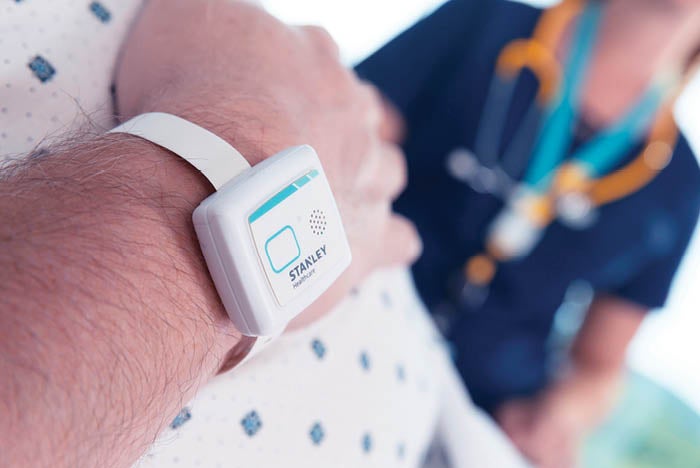
A real-time location system (RTLS), also known as a realtime locating system, can help hospital facilities professionals track key assets and save time, money and lives. But, while primarily used for asset management, these systems are expanding into other areas such as contact tracing, which is especially important during the COVID-19 pandemic.
Market penetration is about 25% of U.S. hospitals and growing, according to manufacturers that supply the nation’s health care facilities.
“With the proliferation of successful RTLS use cases and advances in new wireless tracking technologies, multiple forms of asset tracking are now in existence in approximately 25% to 30% of health care systems in the U.S.,” says Dave Wiedman, chief commercial officer of Vizzia Technologies, Atlanta.
Hospital applications
RTLSs have two core applications in hospitals: asset tracking and patient tracking, according to Garrett Cathey, commercial manager of technology solutions for the U.S. and Canada at GE Healthcare, Chicago. “Asset tracking is a great way to get started if a hospital is new to RTLSs because it has a wide horizontal impact across the organization, from clinical engineering to nursing staff.”
Asset management is the main RTLS service that provides maximum value for hospitals, manufacturers say. The automated tracking of staff, patients and equipment offers a demonstrable return on investment in terms of saving time, money and outcomes. Increasingly, existing RTLS solutions are being leveraged to improve patient workflow within hospitals and clinics.
Beyond asset management, RTLSs are often used for patient flow tracking in hospitals and outpatient clinics; environmental monitoring of refrigerators, freezers and rooms; staff backup when assistance is needed; and patient rounding.
“Contact tracing of potential infectious disease contacts with patients, staff and equipment has become prevalent,” says Keith Heron, industry and solution strategy director for location-based intelligence at Infor, New York City.
Growing use cases
The number of hospital applications that integrate with RTLS technology is growing rapidly; this includes electronic health records and operating room (OR) management platforms. For example, RTLSs can help manage OR schedules, workflows, and the location and availability of surgical trays, according to Christopher Thompson, director of patient experience at CenTrak, Newtown, Pa.
“Recently, COVID-19 has increased interest in RTLS applications related to infection control. RTLSs can power contact tracing within health care facilities; monitor temperatures, air pressure and other environmental conditions; and help improve rates of hand-hygiene compliance,” Thompson says.
Although RTLS technology has long been used for automated contact tracing, use cases have surged during the COVID-19 pandemic, according to Jeanne Kraimer, product manager with RTLS at Midmark, Traverse City, Mich. “RTLSs enable staff to quickly identify who was exposed to a known source of contagion and implement isolation precautions to help prevent further disease exposure. This is especially critical when a patient’s diagnosis comes several days into an admission or after a patient has visited an outpatient facility.”
Sagi Geva, director of hospital solutions at Stanley Healthcare, Portsmouth, N.H., sees increased interest in RTLS solutions related to people and how they experience the hospital environment.
“Patient flow and staff workflow are well established use cases, but the COVID-19 crisis has brought forward new needs such as contact tracing, proximity alerts to help maintain social distancing, and wayfinding to guide people while in the hospital,” Geva says. “RTLSs can even be used to promote social distancing guidelines through capacity control.”
RTLSs make it easy for hospital teams to quickly conduct inventory checks in pharmacies and supply rooms where items need to be frequently counted, inspected and rotated. Systems are used for specimen identification, tracking and management. With track-and-trace RTLSs, it’s easier for hospitals to ensure a complete chain of custody for specimens during collection, transport to the lab, testing and results reporting.
“RTLSs also can help eliminate theft and misplaced items,” says Lana Leone, senior marketing manager for Zebra Technologies North American Healthcare Solutions, Lincolnshire, Ill. “Assets can be tracked in real time to prevent theft. Tags can be applied to high-value items so that alarms are raised when assets cross an unauthorized physical threshold.”
RTLSs also play a role in smaller, offsite health care facilities, a fast-growing market segment.
Anne Bugge, president and CEO of Sonitor Technologies Inc., Greenwich, Conn., has seen the value that RTLSs deliver across a wide range of off-site facilities including ambulatory, orthopedic clinics and senior living facilities. “For example, Altru Advanced Orthopedics, Grand Forks, N.D., deployed Sonitor’s ultrasound-based RTLS and decreased patient visit cycle times by 25%, ultimately increasing patient access and clinic capacity, adding 1,700 more patient visits and driving a 24% increase in annual net revenue,” she says.
At the Sanford Moorhead Clinic, Moorhead, Minn., RTLSs allow for self-rooming, which reduces the number of waiting room chairs needed by 50%. “During a time when social distancing is critical to ensure the health and safety of patients visiting clinics, reducing the number of people having to stay in common areas is a necessity,” Bugge says.
Capturing data
Data capture is a key capability of the latest RTLSs, allowing hospitals to inform a variety of operational improvements. Systems can be used to ensure that assets are available when needed and help prevent overspending on unnecessary equipment. RTLS data also can be used to optimize a facility’s workforce, ensuring that the hospital is properly staffed.
“RTLSs can help track and report key metrics, such as door-to-doc time in the emergency room, patient throughput and wait times,” Thompson says. “For large health care systems, enterprise RTLSs provide the ability to tie multiple facilities together, so you don’t lose visibility as patients, staff and assets move between locations.”
With so many RTLS options available, different locating technologies provide different levels of accuracy, which impacts the effectiveness of the data, according to Kraimer. “This is an important consideration when evaluating RTLS solutions to support specific business objectives,” she says. “What kind of granularity is needed to support contact tracing and other operational improvements? For example, zone-level locating is not granular enough to support process efficiency efforts in an oncology clinic that sees multiple patients in the same area.”
Artificial intelligence and the Internet of Things (IoT) also are key players in RTLS development.
“More and more internet-connected medical devices are able to generate and transmit data accurately,” Wiedman says. “The data, along with the devices themselves, are creating the Internet of Medical Things (IoMT) — a connected ecosystem of equipment, software applications and related services.”
Both artificial intelligence and new sensor technologies enabled by the IoT are natural parts of the evolution of RTLS solutions, according to Geva. “The data set created by RTLSs, showing the interactions of people, things and spaces, holds all kinds of insights that are ripe for artificial intelligence-assisted analysis to support visual dashboards and reports,” he says. “Artificial intelligence matters most in areas where historical data trends can affect future decision making.”
With the help of artificial intelligence tools, RTLS data can be turned into actionable insights that can be used for routine improvements and to generate predictive data, according to Bugge. “For example, during the COVID-19 pandemic, RTLS data captured on the flow of staff and patients, staff capacity and medical assets can be matched with data taken from other hospital data sources to create a picture of the health care landscape during the pandemic,” she says. “This combined data can be analyzed to prepare for a possible second wave.”
Innovations abound
Among new RTLSs available to the hospital market, Midmark has introduced wireless sensory network and Wi-Fi locating options that can be mixed and matched to suit a facility’s needs for flexibility of installation, maintenance and desired precision of coverage. The company also has unveiled patient flow optimization modules designed to help outpatient clinics take a stepwise approach to improving patient flow and space utilization.
CenTrak recently added bluetooth low energy (BLE) to its RTLS platform. The BLE beacons are battery-operated, last up to five years and are easily managed via the company’s Connect Pulse platform. “BLE beacons can be turned on and off remotely and licensed independently. If a facility has a CenTrak RTLS infrastructure in place, BLE beacons can support applications that don’t require the precision of infrared technologies,” Thompson says.
Sonitor offers two complementary platforms for contact tracing designed to prevent and control the spread of COVID-19 in hospitals. Sonitor Sense RTLS is a wearable technology that leverages ultrasound-based transmitters to track and monitor patient location and movement, all hospital staff that an infected patient has interacted with, all medical equipment that a patient may have come in contact with, and interactions that an infected staff member may have had with other staff, patients or equipment. Forkbeard Peer to Peer is an infrastructure-less solution that leverages smartphones and a downloadable app to enhance these capabilities.
Stanley Healthcare has introduced a contact tracing solution that enables hospitals to quickly identify which patients, visitors and staff may have been close to someone who tests positive for COVID-19. It leverages the hospital’s RTLS infrastructure and software. Reports can be run in minutes, showing who may have been exposed and what parts of the hospital should be the focus of cleaning. Data are securely stored on-site and are accessible only to authorized individuals.
Infor has released the AccuRound mobile application, which can be used by clinical staff to record observation and rounding data for patients who require periodic reassessment. It provides several screens that may be accessed on a portable iPad or other notebook device. It also displays a prioritized list of all patients assigned to a specific care provider, including the patient name, a photo, clinical information and last known location. A key feature on all screens is the ability to activate a call for assistance, which broadcasts an alert.
Vizzia Technologies also offers automatic contact tracing. It provides realtime records of location data for staff, patients and medical devices as well as information regarding interactions between them. This automated solution allows users to quickly identify and locate patients, staff and equipment that may be at risk.
Zebra Technologies offers a portfolio of intelligent RTLS solutions, which includes its BLE hardware and radio-frequency identification (RFID) technology, enabling hospitals to track patients, assets and staff with different applications. Utilizing tracking beacons that are attached to people and devices, these RTLS solutions are simple to install and enable crowdsourcing to locate assets and people through mobile readers.
GE Healthcare offers Encompass, a web-based, cloud-deployed RTLS technology that tracks, manages and analyzes location data for mobile assets. It helps facilities managers locate lost hospital equipment such as wheelchairs, infusion pumps and monitors. The system readily scales to accommodate growth and can be easily reconfigured if hospital layouts are redesigned.
Shining a light
Looking ahead, experts predict that contact tracing will become even more prominent in hospital RTLSs. “COVID-19 has shined a light on the importance of managing medical assets,” says Cathey, “and we suspect RTLSs for mobile medical asset tracking will be further adopted in the coming years, which will allow us to develop more timely use cases such as contact tracing.”
Neal Lorenzi is a freelance writer and regular contributor based in Mundelein, Ill.
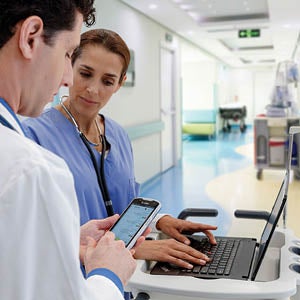
QUICK ACCESS
Asset tracking is one of the primary benefits of RTLS technologies and can help health care providers quickly locate assets, reduce out of stocks and conduct regular inventory checks. Zebra Technologies North American Healthcare Solutions

ROUNDING RELIEF
The AccuRound mobile application has a patient rounding list feature that displays a prioritized list of all patients assigned to a specific care provider. Infor
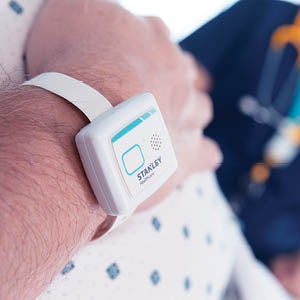
PATIENTS FIRST
RTLS patient bands support people-visibility solutions such as contact tracing and patient flow. Stanley Healthcare
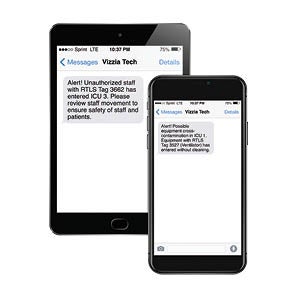
RISK AND REWARD
Vizzia automatic contact tracing sends instant text alerts if staff, patients or equipment are at risk. Vizzia Technologies
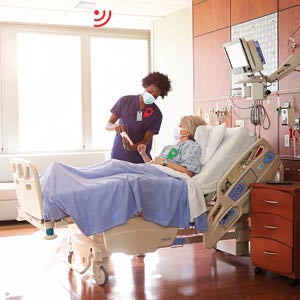
PINPOINT PRECISION
Sonitor Sense, an ultrasound-based RTLS technology platform, provides consistent accuracy down to room, bay, bed and chair level. Sonitor Technologies Inc.
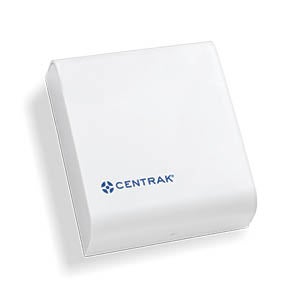
ALWAYS READY
Bluetooth low-energy beacons are battery-operated, provide flexible mounting options and support positioning capabilities for any Bluetooth-enabled device. CenTrak
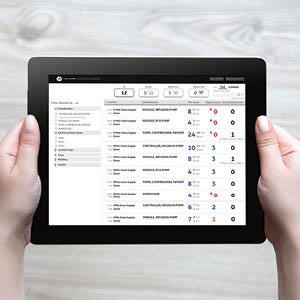
VERSATILE VISION
When clinical staff need a particular asset, they can access its precise location using Encompass mobile applications via any computer, tablet or smartphone. GE Healthcare
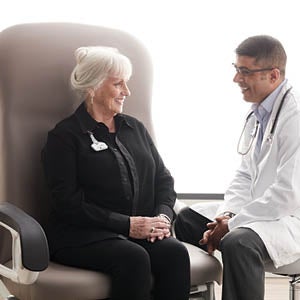
SEEING IS BELIEVING
An RTLS patient flow optimization solution provides staff with a view of everything happening within a clinic. Midmark

